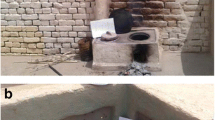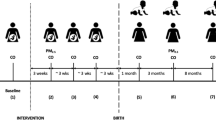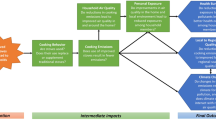Abstract
Domestic cooking with biomass fuels exposes women and children to pollutants that impair health. The objective of the study was to investigate the extent of household air pollution from biomass fuels and the effectiveness of stove intervention to improve indoor air quality, exposure-related health problems, and lung function. We conducted a community-based pilot study in three rural communities in southwest Nigeria. Indoor levels of particulate matter (PM2.5) and carbon monoxide (CO) were measured, and exposure-related health complaints were assessed in 59 households that used firewood exclusively for cooking. Fifty-nine mother–child pairs from these households were evaluated pre-intervention and 1 year after distribution and monitored use of low-emission stoves. Mean age (± SD; years) of mothers and children were 43.0 ± 11.7 and 13.0 ± 2.5, respectively. Median indoor PM2.5 level was 1414.4 μg/m3 [interquartile range (IQR) 831.2–3437.0] pre-intervention and was significantly reduced to 130.3 μg/m3 (IQR 49.6–277.1; p < 0.0001) post-intervention. Similarly, the median CO level was reduced from 170.3 ppm (IQR 116.3–236.2) to 14.0 ppm (IQR 7.0–21.0; p < 0.0001). There were also significant reductions in frequency of respiratory symptoms (dry cough, chest tightness, difficult breathing, and runny nose) in mothers and children. Over 25 % of mothers and children had moderate airway obstruction on spirometry pre-intervention that did not improve 1 year after intervention period. Cooking with firewood causes household air pollution and compromised lung health. Introduction of low-emission stoves was effective at improving indoor air quality and reducing exposure-related symptoms.



Similar content being viewed by others
References
Almond D (2006) Is the 1918 influenza pandemic over? Long-term effects of in-utero influenza exposure in the post 1940 USA population. Journal of Political Economy 114(4):672–712
American Thoracic Society (ATS) (1994) Standardization of spirometry, 1994 update. Am J Respir Crit Care Med 152(3):1107–1136
Ana G, Adeniji B, Ige O, Oluwole O, Olopade CO (2012) Exposure to emissions from firewood cooking stove and the pulmonary health of women in Olrunda community, Ibadan, Nigeria. Air Qual Atmos Health (online version). doi:10.1007/s11869-012-0183-6
Ben-Schlomo Y, Kuh D (2002) A life course approach to chronic disease epidemiology: conceptual models, empirical challenges and interdisciplinary perspectives. Int J Epi 31:285–293
Bruce N, Perez-Padilla R, Albalak R (2000) Indoor air pollution in developing countries: a major environmental and public health challenge. Bull World Health Organ 78(9):1078–1092
Celli BR, MacNee W (2004) Standards for the diagnosis and treatment of patients with COPD: a summary of the ATS/ERS position paper. Eur Respir J 23(6):932–946
Chapman RS, He X, Blair AE, Lan Q (2005) Improvement in household stoves and risk of chronic obstructive pulmonary disease in Xuanwei, China: retrospective cohort study. BMJ 331(7524):1050
Choi J, Kim J, Kim Y, Kim Y, Chung N, Cho M (2004) Comparative study of PM2.5- and PM10-induced oxidative stress in rat lung epithelial cells. J Vet Sci 5(1):11–18
Diaz E, Bruce N, Pope D, Lie RT, Diaz A, Arana B et al (2007) Lung function and symptoms among indigenous Mayan women exposed to high levels of indoor air pollution. Int J Tuberc Lung Dis 11(12):1372–1379
Duflo E, Greenstone M, Hanna R (2008) Cooking stoves, indoor air pollution and respiratory health in rural Orissa. Economic & Political Weekly 43(32):71–76
Dutt D, Srinivasa DK, Rotti SB, Sahai A, Konar D et al (1996) Effect of indoor air pollution on the respiratory system of women using different fuels for cooking in an urban slum of Pondicherry. Natl Med J India 9(3):113–117
Ellegard A (1996) Cooking fuel smoke and respiratory symptoms among women in low income areas in Maputo. Environ Health Perspect 104(9):980–985
Emmelin A, Wall S (2007) Indoor air pollution: a poverty-related cause of mortality among the children of the world. Chest 132(5):1615–1623
Ezzati M, Mbinda MB, Kammen DM (2000) Comparison of emissions and residential exposure from traditional and improved cookstoves in Kenya. Environ Sci Technol 34(4):78–583
Fullerton DG, Bruce N, Gordon SB (2008) Indoor air pollution from biomass fuel smoke is a major health concern in the developing world. Trans R Soc Trop Med Hyg 102(9):843–851
Fullerton DG, Semple S, Kalambo F, Suseno A, Malamba R, Henderson G et al (2009) Biomass fuel use and indoor air pollution in homes in Malawi. Occup Environ Med 66(11):777–783
Hankinson JL, Kawut SM, Shahar E, Smith LJ, Stukovsky KH, Barr RG (2010) Performance of American Thoracic Society-recommended spirometry reference values in a multiethnic sample of adults. Chest 137(1):138–145
Hertzman C, Power C, Matthew S, Manor O (2001) Using an interactive framework of society and lifecourse to explain self-rated health in early adulthood. Soc Sci Med 53:1575–1585
Kurmi OP, Semple S, Steiner M, Henderson GD, Ayres JG (2008) Particulate matter exposure during domestic work in Nepal. Ann Occup Hyg 52(6):509–517
McCracken JP, Smith KR, Diaz A, Mittleman MA, Schwartz J (2007) Chimney stove intervention to reduce long-term wood smoke exposure lowers blood pressure among Guatemalan women. Environ Health Perspect 115(7):996–1001
Naeher LP, Leaderer BP, Smith KR (2000) Particulate matter and carbon monoxide in highland Guatemala: indoor and outdoor levels from traditional and improved wood stoves and gas stoves. Indoor Air 10(3):200–205
Naeher LP, Brauer M, Lipsett M, Zelikoff JT, Simpson CD, Koenig JQ et al (2007) Woodsmoke health effects: a review. Inhal Toxicol 19:67–106
Obueh J (2006) Methanol stoves for indoor air pollution reduction in Delta State, Nigeria. Bioling Point 52:26–29
Padhi BK, Padhy PK (2008) Domestic fuels, indoor air pollution, and children's health. Ann N Y Acad Sci 1140:209–217
Pauwels RA, Buist AS, Calverley PM, Jenkins CR, Hurd SS (2001) Global strategy for the diagnosis, management, and prevention of chronic obstructive pulmonary disease. NHLBI/WHO Global Initiative for Chronic Obstructive Lung Disease (GOLD) Workshop summary. Am J Respir Crit Care Med 163(5):1256–1276
Regalado J, Perez-Padilla R, Sansores R, Paramo RJI, Brauer M, Pare P et al (2006) The effect of biomass burning on respiratory symptoms and lung function in rural Mexican women. Am J Respir Crit Care Med 174(8):901–905
Romieu I, Castro-Giner F, Kunzli N, Sunyer J (2008) Air pollution, oxidative stress and dietary supplementation: a review. Eur Respir J 31(1):179–197
Romieu I, Riojas-Rodriguez H, Marron-Mares AT, Schilmann A, Perez-Padilla R, Masera O (2009) Improved biomass stove intervention in rural Mexico: impact on the respiratory health of women. Am J Respir Crit Care Med 180(7):649–656
Saha A, Kulkarni PK, Shah A, Patel M, Saiyed HN (2005a) Ocular morbidity and fuel use: an experience from India. Occup Environ Med 62(1):66–69
Saha A, Rao NM, Kulkarni PK, Majumdar PK, Saiyed HN (2005b) Pulmonary function and fuel use: a population survey. Respir Res 6:127
Salvi S, Barnes P (2010) Is exposure to biomass smoke the biggest risk factor for COPD globally? Chest 138(1):3–5
Shrestha IL, Shrestha SL (2005) Indoor air pollution from biomass fuels and respiratory health of the exposed population in Nepalese households. Int J Occup Environ Health 11(2):150–160
Siddiqui AR, Lee K, Gold EB, Bhutta ZA (2005) Eyes and respiratory symptoms among women exposed to wood smoke emitted from indoor cooking: a study from southern Pakistan. Energy for Sustainable Development 9(3):58–66
Smith KR, Mehta S (2003) The burden of disease from indoor air pollution in developing countries: comparison of estimates. Int J Hyg Environ Health 206(4–5):279–289
Smith KR, Dutta K, Chengappa C, Gusain PPS, Masera O, Berrueta V (2007) Monitoring and evaluation of improved biomass cookstove programs for indoor air quality and stove performance: conclusion from the Household Energy and Health Project. Energy for Sustainable Development 11:15–18
Smith-Severtsen T, Diaz E, Pope D (2009) Effect of reducing indoor air pollution on women's respiratory symptoms and lung function: the RESPIRE Randomized Trial, Guatemala. Am J Epidemiol 170(2):211–220
Sood A, Peterson H, Blanchette C, Meek P, Belinsky S, Picchi M et al (2009) Wood smoke associated chronic obstructive pulmonary disease (COPD) underappreciated in the United States. Am J Respir Crit Care Med 179:A4742
Sumer H, Turaclar UT, Onarlioglu T, Ozdemir L, Zwahlen M (2004) The association of biomass fuel combustion on pulmonary function tests in the adult population of Mid-Anatolia. Soz Praventivmed 49(4):247–253
Torres-Duque C, Maldonado D, Perez-Padilla R, Ezzati M, Viegi G, (Forum of International Respiratory Studies (FIRS) Task Force on Health Effects of Biomass Exposure (2008) Biomass fuels and respiratory diseases: a review of evidence. Proc Am Thorac Soc 5:577–590
World Health Organisation (WHO) (2004) Comparative quantification of health risks: global and regional burden of disease attributable to selected major risk factor. WHO, Geneva
World Health Organization (WHO) (2007) Indoor air pollution takes heavy toll on health: WHO Country by country standing. WHO, Geneva. Available at: http://www.who.int/mediacentre/news/notes/2007/np20/en/index.html
World Health Report (WHR) (2005) Make every mother and child count. World Health Organization Reports. Available at: http://whqlibdoc.who.int/whr/2005/9241562900.pdf
Zhang J, Smith KR (2003) Indoor air pollution: a global health concern. Br Med Bull 68:209–225
Acknowledgments
The Falk Medical Trust Foundation, USA and the Chest Foundation of the American College of Chest Physicians through the Humanitarian award to Christopher Olopade, MD, funded the project. The authors are also grateful to Healthy Life for All Foundation (HLF), Ibadan, Nigeria, for assistance with project execution and to Rebecca Incledon for editorial assistance.
Conflict of interest
None of the authors have a conflict of interest to declare on this project.
Author information
Authors and Affiliations
Corresponding author
Rights and permissions
About this article
Cite this article
Oluwole, O., Ana, G.R., Arinola, G.O. et al. Effect of stove intervention on household air pollution and the respiratory health of women and children in rural Nigeria. Air Qual Atmos Health 6, 553–561 (2013). https://doi.org/10.1007/s11869-013-0196-9
Received:
Accepted:
Published:
Issue Date:
DOI: https://doi.org/10.1007/s11869-013-0196-9




